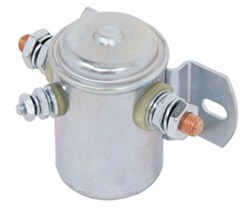
Battery Isolation Solenoid # PK5231201 Not Switching Off 12V Supply on 2004 Toyota Tundra
Question:
I have 12v input from the bat going to the left input post on the solenoid. I have the fuse tap going to the center switch post keyed. I have the charge circuit going from the right post to the camper bat. I still have 12v on the out put right post when the on/off switch circuit center post is on or disconnected. Not switching? This is on my 04 toy tundra
asked by: Jim F
Helpful Expert Reply:
The Battery Isolation Solenoid you referenced, part # PK5231201, installs as you described: the 12V battery feed enters at the left-hand terminal; the center terminal connects with a fuse tap to one of the ignition-controlled circuits in the vehicle (such as the radio or powered antenna); the right-hand terminal is the 12V output to your camper battery. I have attached a photo showing these connection points, just for reference. I also pulled two samples from our stock and tested them both using a portable 12V power supply; both functioned properly.
It is important that this unit be mounted to a conductive metal surface within the engine compartment in order for it to be properly grounded. The two mounting tabs will provide the necessary ground when mounted to a clean bare metal surface. You might want to use some fine grit sandpaper on the mounting location to remove paint to provide this conductive bare metal surface.
You also need to use your fuse tap kit, such as Firestone # F2526, to access an ignition-controlled circuit, such as the radio or power antenna. The circuit you use must be controlled by the ignition switch in order to turn off the 12V camper feed when the Tundra engine is off. Since you have 12V power output all the time chances are that you need just relocate the fuse tap to a different circuit in the fuse panel.

Products Referenced in This Question
Product Page this Question was Asked From
Starter Solenoid - SPST - 12 Volt - 100 Amp - Continuous Duty - Grounded
- Accessories and Parts
- Battery Boxes
- Switches and Solenoids
- 100 Amp
- Pollak
more information >

Continue Researching
- Q&A: Ladder Rack Compatible With Pace Edwards Ultragroove Tonneau on 2023 Ford F-150 With 6-1/2 Foot Bed
- Q&A: Replacement Clearance Lights Needed for GLO-BRITE 122R and 122Y Lights
- Q&A: Is a Battery Isolator Needed When Using 7-Way Connector To Charge the Trailer Battery
- Q&A: Ladder Rack Compatible with BAK Revolver X2 Tonneau Cover
- Q&A: Can I use the Noco Genius5 while my trailers own converter remains connected to the battery?
- Q&A: Can I Add the NOCO Genius On-Board Battery Charger to a System with an Existing Charger
- Q&A: Recommended Battery Isolator for a 2014 GMC Sierra 1500 w/ a 150 amp Alternator
- Article: Trailer Wiring Diagrams
- Article: How to Charge a Trailer Battery While Driving: 3 Common Problems (And How to Fix Them)
- Article: How to Charge a Dump Trailer Battery
- Article: Trailer Maintenance Schedule
- Article: Gooseneck Trailer Hitch Information and Review
- Article: Flat Towing Package for 2016-2018 Chevrolet Silverado 1500
- Article: Breakaway Kit Installation for Single and Dual Brake Axle Trailers








